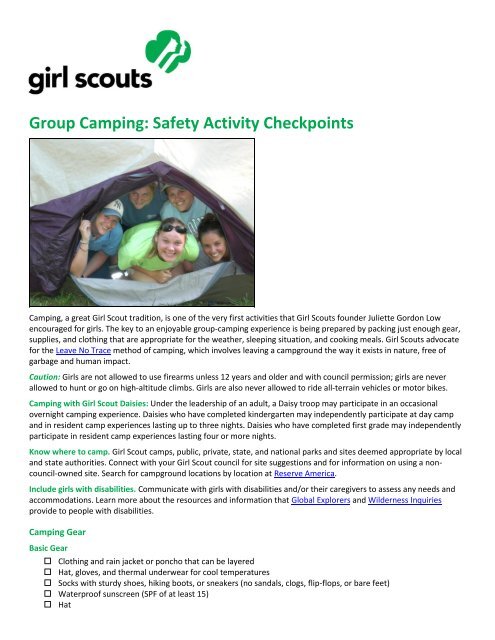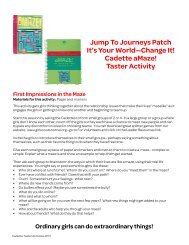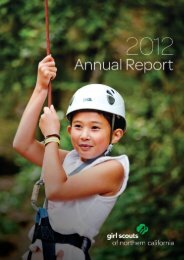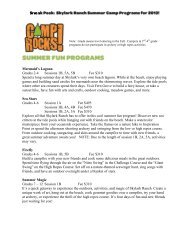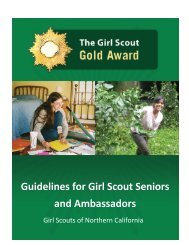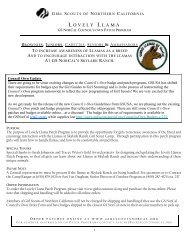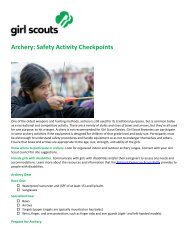Group Camping: Safety Activity Checkpoints
Group Camping: Safety Activity Checkpoints
Group Camping: Safety Activity Checkpoints
- No tags were found...
Create successful ePaper yourself
Turn your PDF publications into a flip-book with our unique Google optimized e-Paper software.
<strong>Group</strong> <strong>Camping</strong>: <strong>Safety</strong> <strong>Activity</strong> <strong>Checkpoints</strong><strong>Camping</strong>, a great Girl Scout tradition, is one of the very first activities that Girl Scouts founder Juliette Gordon Lowencouraged for girls. The key to an enjoyable group-camping experience is being prepared by packing just enough gear,supplies, and clothing that are appropriate for the weather, sleeping situation, and cooking meals. Girl Scouts advocatefor the Leave No Trace method of camping, which involves leaving a campground the way it exists in nature, free ofgarbage and human impact.Caution: Girls are not allowed to use firearms unless 12 years and older and with council permission; girls are neverallowed to hunt or go on high-altitude climbs. Girls are also never allowed to ride all-terrain vehicles or motor bikes.<strong>Camping</strong> with Girl Scout Daisies: Under the leadership of an adult, a Daisy troop may participate in an occasionalovernight camping experience. Daisies who have completed kindergarten may independently participate at day campand in resident camp experiences lasting up to three nights. Daisies who have completed first grade may independentlyparticipate in resident camp experiences lasting four or more nights.Know where to camp. Girl Scout camps, public, private, state, and national parks and sites deemed appropriate by localand state authorities. Connect with your Girl Scout council for site suggestions and for information on using a noncouncil-ownedsite. Search for campground locations by location at Reserve America.Include girls with disabilities. Communicate with girls with disabilities and/or their caregivers to assess any needs andaccommodations. Learn more about the resources and information that Global Explorers and Wilderness Inquiriesprovide to people with disabilities.<strong>Camping</strong> GearBasic Gear Clothing and rain jacket or poncho that can be layered Hat, gloves, and thermal underwear for cool temperatures Socks with sturdy shoes, hiking boots, or sneakers (no sandals, clogs, flip-flops, or bare feet) Waterproof sunscreen (SPF of at least 15) Hat
Sunglasses Towels and basic personal hygiene supplies (shampoo, soap, comb, and so on) Daypack Insect repellentSpecialized Gear Flame-resistant tents or tarp (no plastic tents) Compass and map or map and global positioning system (GPS) Sleeping bag (rated for the anticipated temperature) Mosquito netting where necessary Cooking supplies (pots, pans, utensils, mess kit and dunk bag, and so on) Cooler for food storage Portable cook stoves and fuel whenever possible (to reduce the use of firewood) Flashlight and other battery-powered lights (no candles, kerosene lamps, portable cook stoves, heaters, or otheropen-flame devices are used inside tents) Lantern fueled by propane, butane, kerosene, or gas (for outdoor use) Water-purification kitPrepare for <strong>Group</strong> <strong>Camping</strong> Communicate with council and parents. Inform your Girl Scout council and girls’ parents/guardians about theactivity, including details about safety precautions and any appropriate clothing or supplies that may benecessary. Follow council procedures for activity approval, certificates of insurance, and council guidelines aboutgirls’ general health examinations. Make arrangements in advance for all transportation and confirm plansbefore departure. Girls plan the activity. Keeping their grade-level abilities in mind, encourage girls to take proactive leadershiproles in organizing details of the activity and to plan menus, rules for group living, and on-site activities. Obtain camping credentials. Ensure that the adult has been a part of council group or troop-camp learning onsupervising group camping. <strong>Group</strong> camp education generally covers outdoor program activities, minimal-impactcamping skills, safety procedures and standards, and methods of dealing with homesickness. Arrange for transportation and adult supervision. The recommended adult-to-girl ratios are two non-relatedadults (at least one of whom is female) to every:6 Girl Scout Daisies (See “<strong>Camping</strong> With Girl Scout Daisies” details in this checkpoint’s introduction)12 Girl Scout Brownies16 Girl Scout Juniors20 Girl Scout Cadettes24 Girl Scout Seniors24 Girl Scout AmbassadorsPlus one adult to each additional:4 Girl Scout Daisies (See “<strong>Camping</strong> With Girl Scout Daisies” details in this checkpoint’s introduction)6 Girl Scout Brownies8 Girl Scout Juniors10 Girl Scout Cadettes12 Girl Scout Seniors12 Girl Scout Ambassadors Compile key contacts. Give an itinerary to a contact person at home; call the contact person upon departureand return. Create a list of girls’ parents/guardian contact information, telephone numbers for emergencyservices and police, and council contacts—keep on hand or post in an easily accessible location. Also know thelocation of the nearest landline telephone in case cellular phones do not receive reception. Ensure the safety of sleeping areas. Separate sleeping and bathroom facilities are provided for adult males;many councils make exceptions for girls’ fathers. Ensure the following:
Each participant has her own bed. Parent/guardian permission must be obtained if girls are to share a bed.Adults and girls never share a bed.It is not mandatory that an adult sleep in the sleeping area (tent, cabin, or designated area) with the girls. Ifan adult female does share the sleeping area, there should always be two unrelated adult females present.During family or “He and Me” events (in which girls share sleeping accommodations with males), ensure thedetails are clearly explained in parent/guardian permission slip. Girls share resources. Encourage girls to make a list of the gear and supplies, and determine what can beshared. Support girls in creating a checklist of group and personal equipment and distribute to group members. Prepare for emergencies. Ensure the presence of a waterproof first-aid kit and a first-aider with a currentcertificate in First Aid, including Adult and Child CPR or CPR/AED, who is prepared to handle cases fromextremes of temperature, such as heat exhaustion, heat stroke, frostbite, cold exposure, hypothermia, as well assprains, fractures, and altitude sickness. If any part of the activity is located 30 minutes or more from emergencymedical services, ensure the presence of a first-aider with Wilderness First Aid. A vehicle is available or anambulance is on call at all times to transport an injured or sick person. See Volunteer Essentials for informationabout first-aid standards and training.On the Day of <strong>Group</strong> <strong>Camping</strong> Get a weather report. On the morning of the camping trip, check weather.com or other reliable weathersources to determine if conditions are appropriate. If severe weather conditions prevent the camping trip, beprepared with a backup plan or alternate activity. Write, review, and practice evacuation and emergency plansfor severe weather with girls. Use the buddy system. Girls are divided into teams of two. Each girl chooses a buddy and is responsible forstaying with her buddy at all times, warning her buddy of danger, giving her buddy immediate assistance if safeto do so, and seeking help when the situation warrants it. If someone in the group is injured, one person caresfor the patient while two others seek help. Respect the environment and keep campsite clean. Use the principles of minimal-impact camping described byLeave No Trace. Store garbage in insect- and animal-proof containers with plastic inner linings, and cover itsecurely when there is a campsite garbage-pickup service. When there is no garbage-pickup service, removegarbage from campsite in plastic bags and discard, as appropriate. Recycle whenever possible. Do not bury food;carry out garbage, grease, and fuel canisters. Do not remove natural materials such as leaves or branches. Be prepared for primitive campsites. For sites that don’t have electric lights and toilet facilities, observe thesestandards:Choose and set up campsite well before dark.Use a previously established campsite if available.Make sure the campsite is level and located at least 200 feet from all water sources and below tree line.Avoid fragile mountain meadows and areas of wet soil.Avoid camping under dead tree limbs.Use existing fire rings if a fire is necessary.If a latrine is not available, use individual cat holes—holes for human waste that are at least 200 feet awayfrom the trail and known water sources—to dispose of human waste (visit www.lnt.org for moreinformation).Do dishwashing and personal bathing at least 200 feet away from water sources.Store food well away from tents and out of reach of animals. Where necessary, hang food at least 10 feethigh from a rope stretched between two trees. If the site is in bear country, check with local authorities onprecautions to take.See that garbage, tampons, sanitary supplies, and toilet paper are carried out.<strong>Group</strong> <strong>Camping</strong> LinksAmerican Camp Association: www.acacamps.orgGo <strong>Camping</strong> America: www.gocampingamerica.com
Leave No Trace: http://www.lnt.orgNational Camp Association: www.summercamp.org<strong>Group</strong> <strong>Camping</strong> Know-How for GirlsCreate a camp kaper chart. Divvy up cooking duties and get creative about pre-planning outdoor meals.Be ready with camp entertainment. Before you go camping, read about camping stories, songs, activities, andgames.<strong>Group</strong> <strong>Camping</strong> JargonKindling: Small pieces of dry wood used to start a campfireMummy bag: A sleeping bag that is tapered at the ends to reduce air space and to conserve heat


